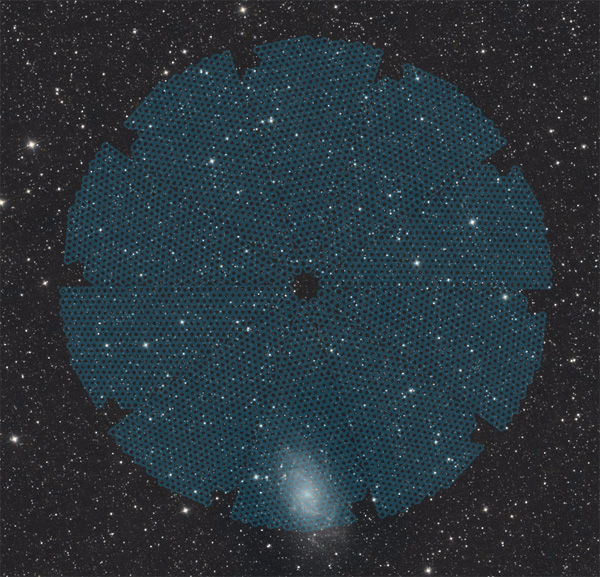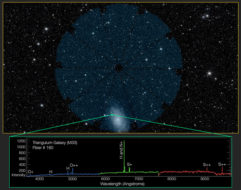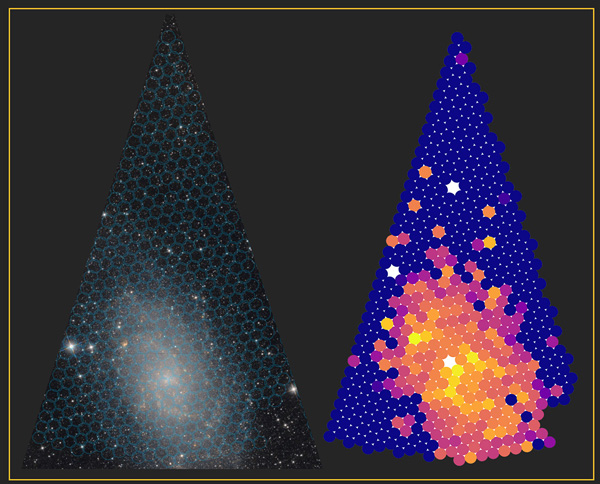Dark Energy Survey Sees First Light – Sky & Telescope
The Dark Energy Spectroscopic Instrument is poised to record millions of galaxies as far back as 11 billion years ago to unveil the nature of dark energy.

The first light image of the Dark Energy Spectroscopic Instrument (DESI) captured the Triangulum Galaxy. DESI’s 5,000 spectroscopic “eyes” cover an area of sky approximately 38 times the area of the full Moon, as seen in this overlay of DESI’s focal plane on the night sky.
DESI Collaboration / Legacy Surveys / NASA / JPL-Caltech / UCLA
Nearly 500 researchers at 75 institutions in 13 countries are working to shed light on dark energy. Their five-year project relies on a new instrument being commissioned on the 4-meter Mayall telescope at the Kitt Peak National Observatory in Arizona. The Dark Energy Spectroscopic Instrument (DESI) is set to revolutionize astronomy — again.

In the test spectrum captured by DESI on October 22nd, light from the Triangulum Galaxy (M33) is dispersed into a spectrum, which contains information about the elements present in the galaxy, as well as spectral lines that can help astronomers measure the galaxy’s distance.
DESI Collaboration / Legacy Surveys / NASA / JPL-Caltech / UCLA / NSF’s National Optical-Infrared Astronomy Research Laboratory
Two decades ago, the Sloan Digital Sky Survey (SDSS) remade the field when it mapped one-third of the sky over the 2.5-meter telescope at Apache Point Observatory in New Mexico. Thousands of studies are based on the three-dimensional map of the universe it created.
That survey also included spectra, taken using custom-drilled metal plates with a thousand holes corresponding to individual stars and galaxies. Once the plates were installed on the telescope, workers painstakingly fitted fiber-optic cables to every hole by hand, enabling the objects’ light to reach the SDSS spectrograph. In this way, the SDSS could measure spectra of around 1,000 objects at a time.
In so doing, SDSS basically introduced astronomy to the era of Big Data. Now, DESI will up the game. The new survey, says Jeffrey Newman (University of Pittsburgh), aims to map out 10 times the volume of the most recently completed phase of the SDSS (SDSS-III), look five times further into the universe’s past, and chart 50 times as many galaxies.

The robotic positioners, which place the fiber-optic cables that gather light from individual galaxies and stars, are arranged in 10 wedge-shaped modules called “petals”. Left: One petal includes the galaxy M33. Blue circles mark the regions from which the 500 fiber-optic cables capture light. Right: Hydrogen-line emission is shown as a color map, with brighter colors indicating brighter emission and a greater abundance of the gas.
DESI Collaboration / Legacy Surveys / NASA / JPL-Caltech / UCLA / NSF’s National Optical-Infrared Astronomy Research Laboratory
Part of the reason for DESI’s increased range is automation. Like the SDSS, DESI collects an object’s light via a fiber-optic cable before spreading it into a spectrum. But unlike the SDSS, DESI will take those spectra 5,000 objects a time at an amazing speed. Humans are no longer involved in the placement of the cables — instead, robots will reposition 5,000 cables every 20 minutes in a humming, choreographed dance. Under ideal conditions, DESI will collect information on more than 100,000 galaxies per night.
The DESI camera has a field of view of 8 square degrees, or 40 times the area of the full Moon, and astronomers expect it to image and take a spectrum of 10 million stars and 35 million galaxies, looking as far back as 11 billion years ago.
DESI is primed to map the universe and enable the study of its namesake, dark energy, a mysterious force that appears to be accelerating the expansion of the universe. But there’s more to DESI than cosmological studies.
“DESI is perfectly designed for the exploration of the unknown,” says Arjun Dey (Kitt Peak National Observatory). “Among the millions of galaxies and stars DESI will study, there are rare, perhaps one-of-a-kind, astronomical sources, some completely unanticipated, that await discovery.”






